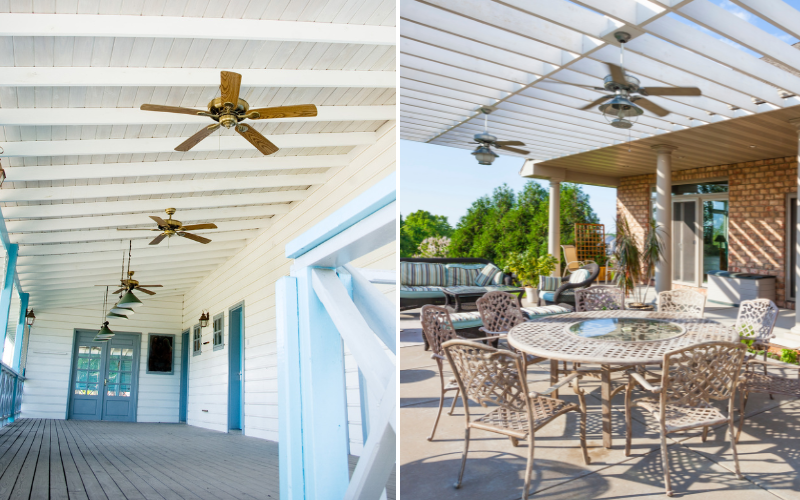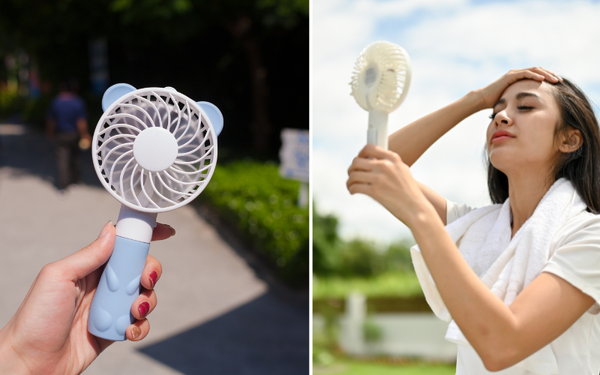When the summer sun warms your outdoor patio to uncomfortable highs, the right fan can be your oasis of cool relief. So, what type of fan is best for your space? We’ll help you sort through options based on patio size, exposure to weather, and fan efficiency to find the ideal choice that promises a comfortable and inviting outdoor environment. In this guide, we will specifically discuss “what type of fan is best for outdoor patio” to ensure you make the best decision for your needs.
Key Takeaways
- The ideal outdoor fan selection depends on factors like the size of the patio, the number of blades, motor quality, and weather resistance, ensuring effective cooling suitable for the specific outdoor conditions.
- Outdoor fans vary in type, functionality, and designs, with options including ceiling, wall-mounted, floor, and pedestal fans, each suited for different spatial and aesthetic preferences with energy-saving potential like Energy Star certification and LED lighting.
- Smart features in outdoor fans such as voice control, smartphone app integration, and traditional remotes, offer user convenience, while proper installation and regular maintenance are vital for safety and longevity.
Determining the Right Fan for Your Outdoor Patio
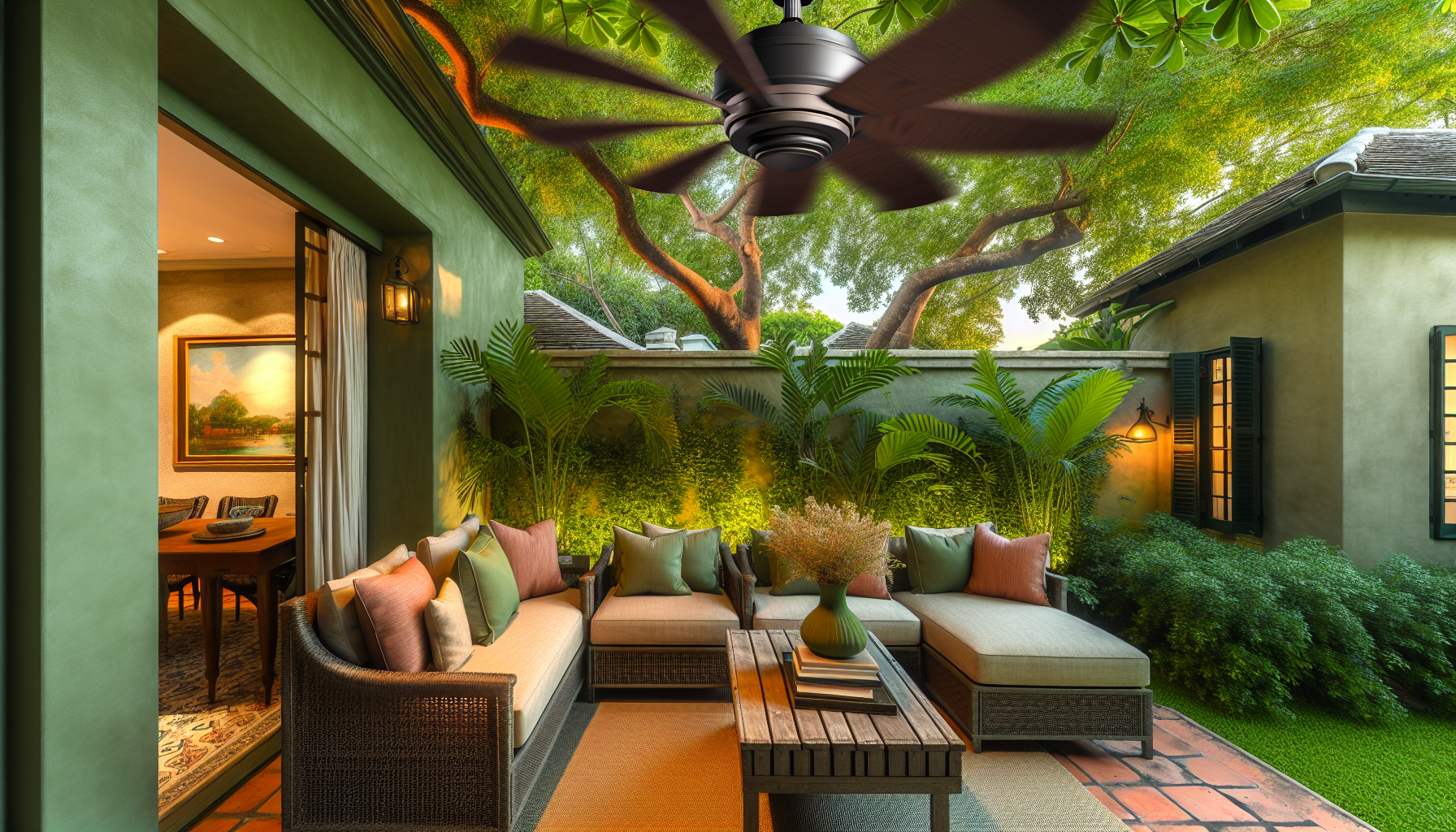
Several factors demand careful consideration when selecting the ideal outdoor ceiling fan. Foremost among these are the size of your outdoor living space and the number of blades on the fan. A larger patio may require a bigger fan with more blades, while a smaller area might be better served by a sleek, three-blade fan. The fan’s motor also plays a significant role; a quieter fan with a powerful motor can provide a cooling breeze without disruptive noise.
The damp or wet rating of the ceiling fan is another crucial determinant in your selection. A fan that’s going to be exposed to the elements needs a higher wet rating than a fan installed under a covered porch. The material of the fan is also significant; the best outdoor ceiling fans are made from weather-resistant materials that can withstand harsh weather conditions.
Size and Space Requirements
Size is a significant factor for outdoor ceiling fans. The fan needs to be large enough to effectively cool the area, but not so large that it overwhelms the space. For instance, a 29-inch fan is suitable for a space of 75 square feet, whereas a 50 to 54-inch fan is appropriate for an area ranging from 226 to 400 square feet.
The blade span of the fan also plays a crucial role in its effectiveness. For small to medium-sized areas, a fan with a blade span of 44-52 inches is recommended. For larger outdoor spaces, a fan with a blade span of 56 inches or larger is ideal. The fan speeds can be adjusted according to the size of the area and the desired level of air circulation.
Location and Weather Conditions
The fan’s suitability also heavily depends on the location and weather conditions of your outdoor space. There are three classifications for outdoor ceiling fans:
- Dry-rated: Suitable for indoor use only.
- Damp-rated: Designed to withstand moisture and humidity but should not be directly exposed to the elements.
- Wet-rated: Can withstand rain and other weather conditions without any problems.
Damp-rated outdoor ceiling fans are suitable for covered areas, while wet-rated fans are durable enough for sun-exposed locations like decks and gazebos. It’s important to note that indoor fans are not suitable for outdoor use, even in covered patios or porches, due to their lack of design to withstand outdoor conditions and moisture.
Purpose and Functionality
The fan’s primary purpose significantly influences the selection process. If the main objective is to cool the area, an outdoor ceiling fan constructed with durable and weather-resistant materials is the best choice.
For those seeking an outdoor fan that also offers lighting, it’s important to look for features such as dimmable lights, a range of bulb options, and integrated light fixtures that can help save space. A smart outdoor ceiling fan can also offer additional convenience and control options, such as remote control and integration with smart home systems.
Types of Outdoor Fans: Ceiling, Wall-Mounted, and Floor

Different types of outdoor fans exist, each offering unique benefits. The three main categories include:
- Ceiling fans: installed from above and have the capacity to circulate a larger volume of air compared to wall-mounted fans.
- Wall-mounted fans: designed to propel air through a given space and may include an oscillating feature.
- Floor fans: versatile and can be placed anywhere in the outdoor space, making them easy to move and adjust for optimal air circulation.
Every fan type boasts distinct properties and advantages. Here are some examples:
- Ceiling fans offer widespread airflow and are well-suited for open or covered patios.
- Wall-mounted fans are suitable for smaller spaces or areas with limited floor space, offering targeted airflow.
- Floor fans are versatile and can provide optimal air circulation in various outdoor spaces.
Outdoor Ceiling Fans
Due to their overhead airflow and potential to include lighting options, outdoor ceiling fans are a popular choice. They offer a broad range of control options, such as:
- Multiple speeds
- A reverse function for circulating air upwards in colder seasons
- Diverse control options like pull chains, remote controls, and wall controls.
Outdoor ceiling fans are generally designed with the following features:
- 52-inch blade span
- Three to five blades made from durable materials like ABS plastic
- Inclusion of a downrod to maintain the appropriate distance from the floor, which can be selected based on the patio’s profile and ceiling height.
Wall-Mounted Outdoor Fans
For smaller spaces or areas with limited floor space, wall-mounted fans serve as an excellent option. They provide targeted airflow and may include an oscillating feature. The fans are advantageous for outdoor patios as they do not occupy any floor space, thereby enabling greater freedom of movement.
Safety is a crucial factor when using wall-mounted fans. They offer the advantage of minimizing the risk of electrical shock by eliminating outdoor wires. Additionally, they may feature UV protective blades or thicker solid wood blades that are designed for outdoor wet or damp locations.
Floor and Pedestal Fans
For patios requiring flexible cooling options, floor and pedestal fans, with their versatility and portability, make a perfect choice. These fans have the capability to circulate air in various directions, enhancing their effectiveness in cooling expansive areas. Furthermore, pedestal fans are easily portable and can be relocated to different positions as required.
To achieve optimal airflow with floor and pedestal fans, follow these recommendations:
- Position the fan to face the opposite wall from the primary activity area.
- When using pedestal fans, place them in diagonal corners to encourage cross ventilation.
- Adjust the height of the fan to circulate air from a higher angle.
Following these tips will help you maximize the effectiveness of your fans and their fan speed, keeping your space cool and comfortable.
Outdoor Fan Styles and Designs
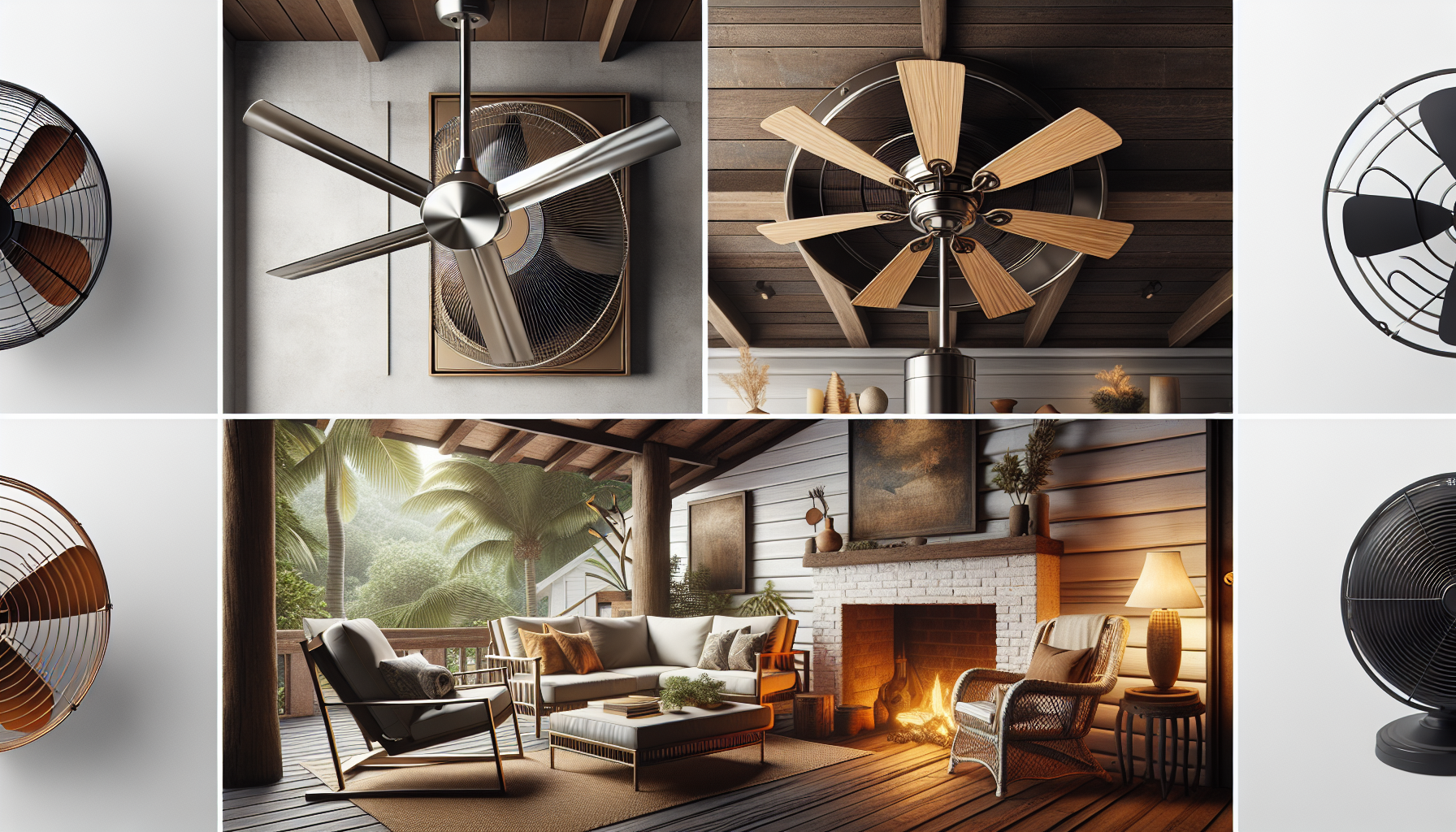
Outdoor ceiling fans offer a wide array of styles, including the best outdoor ceiling fan options in:
- Farmhouse-style
- Modern
- Traditional
- Industrial designs
In contrast, an indoor ceiling fan may have a different set of styles to choose from.
The style you choose can significantly impact the ambiance of your outdoor space. Whether you’re going for a rustic farmhouse look or a sleek, modern aesthetic, there’s a fan design to match.
The fan’s design is not just about aesthetics. It can also influence the fan’s performance. For instance, a fan with a larger blade span may provide more airflow, while a fan with a smaller blade span might be quieter. Additionally, the design can impact the fan’s durability, especially for outdoor fans that are exposed to the elements.
Modern and Contemporary
Modern and contemporary outdoor fans are recognized for their:
- Elegant designs
- Minimalist aesthetics
- Durable materials suitable for outdoor conditions
- Powerful motors for effective air circulation
In addition to their sleek designs, contemporary outdoor fans also offer advancements in technology. These improvements have led to quieter motors, improved airflow, and reduced energy consumption. These features are available in a range of modern designs, making them well-suited for minimalist or contemporary outdoor settings.
Traditional and Classic
Traditional and classic outdoor fans are characterized by their enduring design and sophisticated finishes. They often feature finishes such as:
- oil-rubbed bronze
- bronze
- iron
- nickel
- pewter
- black finishes
- other metal finishes
Traditional and classic outdoor fans not only provide functional cooling but also enrich patio styles by harmonizing with the current decor and introducing extra aesthetic appeal. They bring both functionality and style to the outdoor area, making them a versatile choice for various patio styles.
Rustic and Farmhouse
Rustic and farmhouse style fans are distinguished by their unique aesthetic. They feature weathered-looking blade finishes, natural wood tones, and metal accents. These fans commonly utilize materials such as brushed nickel, bronze, black, wooden finishes, and metal hardware to achieve their unique aesthetic.
Vintage-inspired designs in outdoor fans enhance the overall appeal by eliciting nostalgia and fostering a cozy ambiance. They augment the space’s allure and character through their antique-like aesthetics, adding a touch of warmth and charm to your outdoor space.
Smart Features and Controls for Outdoor Fans
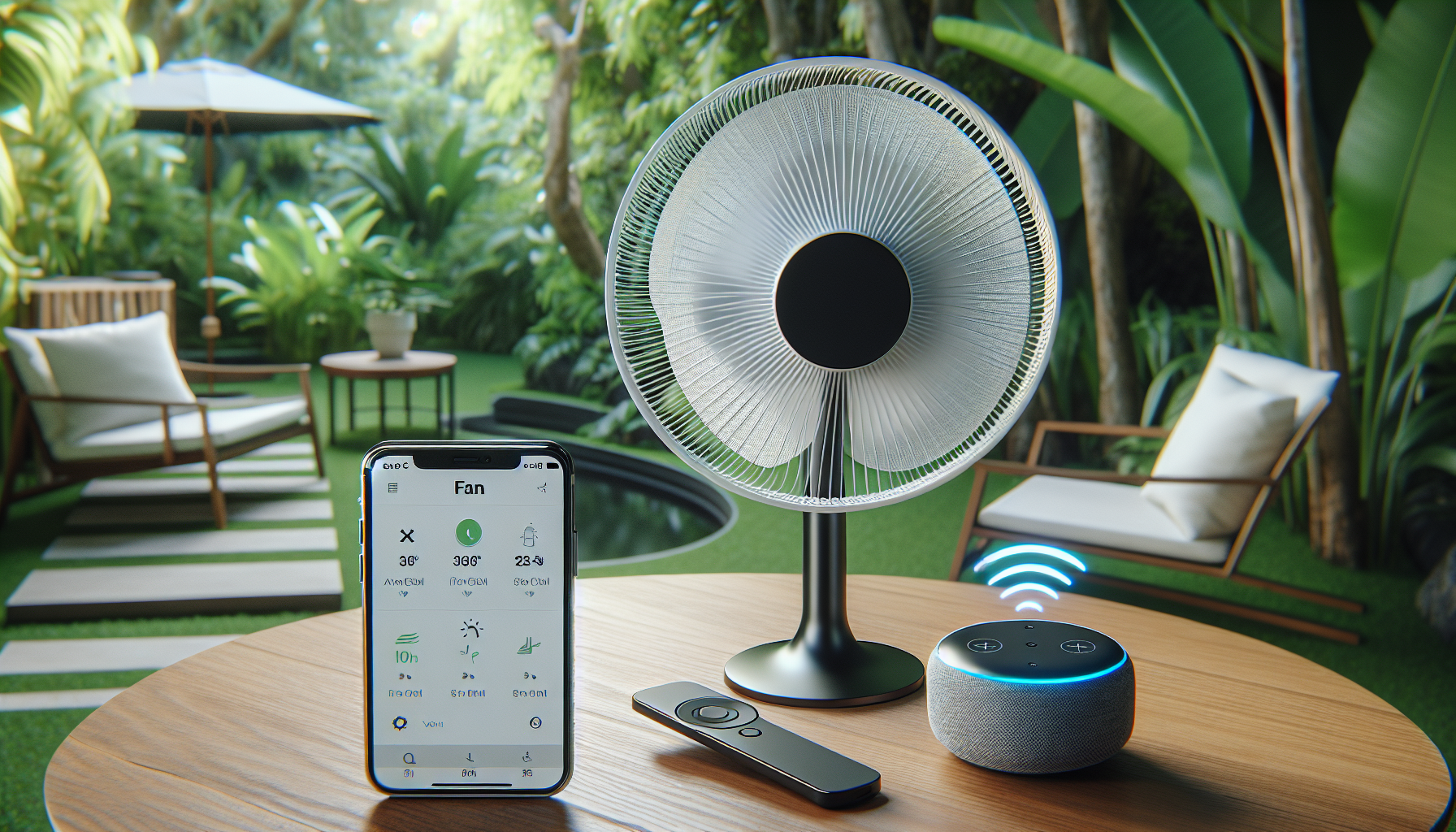
Even outdoor fans have adapted to today’s digital age by incorporating smart features. Many fans now come equipped with smart features that can enhance your fan experience. Smart features include remote controls, voice-activated features, and compatibility with smart home systems.
Smart outdoor fans usually have the following features:
- They establish connections through WiFi and/or Bluetooth
- They can be managed using a dedicated smartphone application
- They have voice control functionality, allowing users to modify speed, direction, and other settings through voice commands, typically through companion apps or voice assistants such as Alexa or Google Assistant.
Smart App and Voice Control
Commanding your outdoor fan through a smartphone app or voice assistant offers multiple benefits like convenience, energy efficiency, and synchronization with smart home systems. You can turn the fan on or off, adjust the speed, set timers, and even control the lighting with just a few taps on your smartphone or voice commands.
Setting up voice control with your outdoor fan involves connecting the fan to a smart device or hub. This enables the use of voice commands to control the fan’s speed, turn it on or off, and even set timers or schedules.
Some recommended smartphone apps for controlling outdoor fans include ASmart Remote IR, ZaZa Remote-Universal Remote, AnyMote Universal Remote +WiFi, and others.
Remote Control and Wall Switch Options
Apart from smart controls, traditional remote controls and wall switches are also popular control options for outdoor fans. These controls allow you to manage the fan’s speed, direction, and lighting. The features that can be controlled with the remote control or wall switch of outdoor fans include speed control, light control, timer settings, and on/off control.
Wall switches are utilized to regulate outdoor fans by connecting them to the fan’s motor and light. If there is a need to incorporate a remote control, adjustments to the setup might be required, and it is advisable to seek guidance from a professional or online resources.
Energy Efficiency and Outdoor Fans
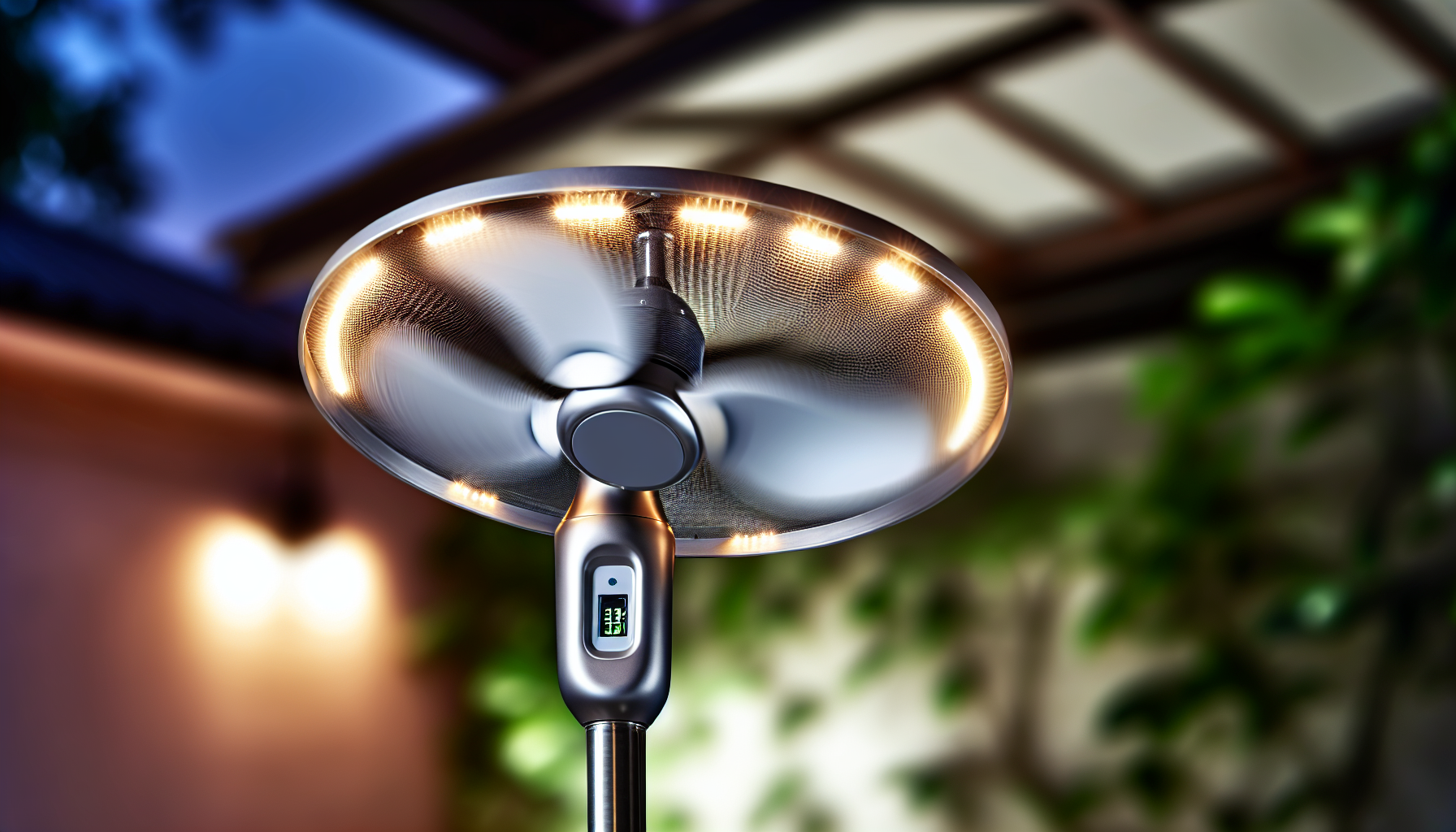
When choosing an outdoor fan, energy efficiency is a key consideration. Not only can an energy-efficient fan save you money on your energy bills, but it can also reduce your carbon footprint.
Here are some benefits of outdoor ceiling fans with Energy Star certification:
- They can achieve up to 40% greater efficiency compared to standard models
- They result in substantial energy savings
- They decrease operational expenses in the long run
In addition to the fan itself, the lighting options can also contribute to the fan’s overall energy efficiency. LED lighting options consume less energy than traditional lighting options. Integrating LED lights directly with the fan’s electrical system provides a more energy-effective solution, thereby enhancing the overall efficiency of the fan.
Energy Star Certification
Outdoor fans with Energy Star certification have undergone rigorous testing to meet specific energy efficiency standards. These fans are engineered with features that conserve energy and decrease greenhouse gas emissions.
By choosing an outdoor fan with Energy Star certification, you can ensure that you’re getting a product that’s been tested for energy efficiency. This not only helps you save on your energy bills but also contributes to environmental conservation.
LED Lighting Options
LED lights in outdoor fans provide a host of advantages over traditional lighting options. Here are some of the benefits:
- They consume less energy
- They have a longer lifespan
- They provide rapid illumination
- They are eco-friendly
- They are available in a variety of color options.
LED lights generally have a lifespan of 4 to 6 years, or approximately 35,000 to 100,000 hours of use, making them a resilient lighting choice. Replacing an LED light in an outdoor fan is a straightforward process that involves removing the old LED light and installing the new one.
Installation and Maintenance Tips
The installation and maintenance of an outdoor fan demand meticulous planning and consistent care. Whether you’re planning a DIY installation or hiring a professional, it’s essential to understand each step of the process to ensure safe and effective operation.
To ensure the longevity of your outdoor fan, regular cleaning and maintenance are crucial. It’s recommended to dust outdoor fans weekly and thoroughly clean them every other month. The frequency of maintenance may vary based on the dust levels in your home, but regular upkeep is essential for preventing common maintenance issues.
DIY vs. Professional Installation
For those with basic electrical knowledge and the required tools, DIY installation of an outdoor ceiling fan can be a fulfilling project. It can be a great way to enhance their outdoor space and save on installation costs. However, incorrect execution of these tasks can lead to unforeseen hazards. On the other hand, professional installation ensures a correct and safe setup, and might save you time and potential headaches in the long run.
If you’re considering DIY installation, it’s important to be aware of the potential risks and challenges. These include improper wiring, physical injuries, and regulation issues which may require a professional to address. It’s always wise to consider your skills and limitations before attempting a DIY installation.
Cleaning and Maintenance
Maintaining your outdoor fan’s performance and lifespan necessitates regular cleaning. It’s advisable to clean your outdoor fan at least biannually. However, if you reside in a dusty environment or utilize the fan frequently, more frequent cleaning may be necessary.
For a more thorough cleaning, an extendable ceiling fan duster or a mixture of half vinegar and half water in a spray bottle can be used to wipe down the blades and base. Certain fans may necessitate a small amount of oil, whereas others could require a specialized lubrication spray. It is important to administer the lubricant to each specified lubrication point in accordance with the guidelines provided by the manufacturer.
Summary
In conclusion, the right outdoor fan can greatly enhance the comfort and ambiance of your outdoor living space. By considering factors such as size, location, type, style, smart features, energy efficiency, and maintenance, you can choose a fan that’s perfect for your patio. Whether you prefer a sleek, modern design or a classic, rustic look, there’s a fan out there that will suit your needs and complement your outdoor decor.
Frequently Asked Questions
What size fan do I need for my outdoor patio?
For an outdoor patio up to 75 square feet, a fan with 29-36 inch blades and 1000-3000 CFM is recommended. A 36-42 inch fan with 1600-4500 CFM is suitable for a patio between 76-144 square feet, while a 44-54 inch fan with 2300-6500 CFM is ideal for a patio of 144-225 square feet.
How many CFM do I need for outdoor patio?
You will need a fan with a CFM rating of 2300-6500 for a patio of 144-225 square feet.
Should I put a fan on my patio?
Yes, you should consider putting a fan on your patio, especially if you want to use the space when it's not too hot. A fan can help alleviate discomfort when the temperature reaches 80°F.
What's the difference between a damp-rated and a wet-rated fan?
A damp-rated fan can handle moisture and humidity but should not be directly exposed to the elements, while a wet-rated fan can withstand rain and other weather conditions without issues. Consider your specific needs to choose the right type of fan for your space.
Can I control my outdoor fan with my smartphone or voice assistant?
Yes, many outdoor fans can be controlled using a smartphone app or voice assistant, providing convenient and remote operation of the fan.
You Might Also Like...
